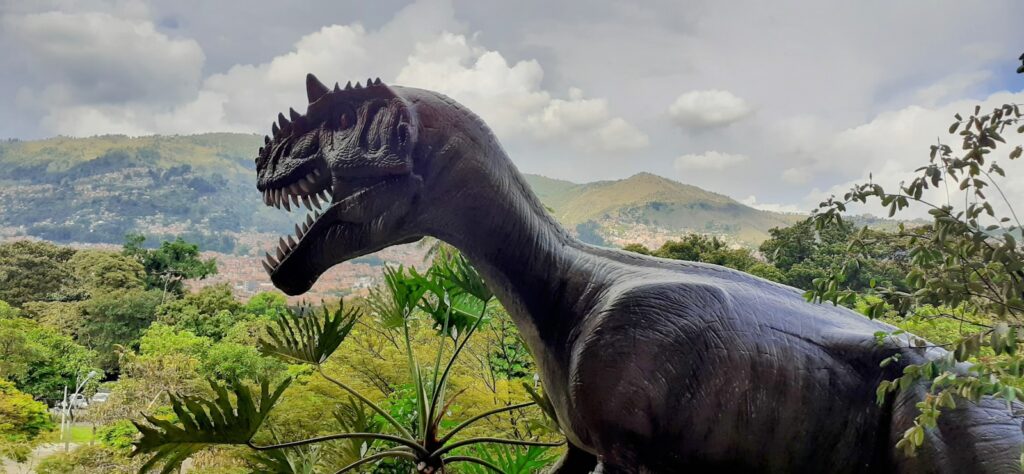Imagine walking through a prehistoric world where colossal beasts thunder across ancient landscapes, their every footstep echoing through time to tell us stories of survival, adaptation, and the relentless march of evolution. The dinosaurs didn’t just rule the Earth for over 160 million years—they rewrote the very rules of life itself, leaving behind clues that continue to revolutionize our understanding of how species transform, adapt, and thrive in an ever-changing world.
The Triassic Foundation: When Dinosaurs First Whispered Their Arrival

The Triassic period, spanning from 252 to 201 million years ago, marked the humble beginnings of what would become the most successful vertebrate dynasty in Earth’s history. During this era, the first dinosaurs emerged as small, bipedal creatures no larger than a modern dog, yet they carried within their genes the blueprint for evolutionary dominance. These early pioneers like Eoraptor and Herrerasaurus demonstrated that evolution often starts with modest experiments before unleashing its most spectacular creations.
What makes the Triassic period so fascinating is how it reveals evolution’s response to catastrophe. The devastating Permian extinction had wiped out 96% of marine species, creating ecological vacuums that early dinosaurs eagerly filled. This period teaches us that evolution doesn’t just gradually refine existing forms—it seizes opportunities created by destruction to launch entirely new evolutionary strategies.
Jurassic Giants: The Era of Evolutionary Extremes
The Jurassic period, from 201 to 145 million years ago, witnessed evolution pushing the boundaries of what seemed physically possible. Sauropods like Brachiosaurus and Diplodocus grew to lengths exceeding 80 feet, their massive bodies defying gravity through ingenious evolutionary solutions. These giants developed hollow bones, efficient heart systems, and specialized digestive processes that allowed them to thrive despite their enormous size.
This era reveals evolution’s tendency to explore extremes when environmental conditions allow. The warm, humid climate and abundant plant life of the Jurassic created perfect conditions for gigantism, showing us that evolution isn’t just about survival—it’s about exploiting every possible niche to its fullest potential.
Cretaceous Complexity: The Renaissance of Dinosaur Diversity
The Cretaceous period, spanning from 145 to 66 million years ago, represents evolution’s masterpiece of diversification. During this time, dinosaurs evolved into an astounding array of forms, from the fearsome Tyrannosaurus rex to the delicate, feathered Microraptor. This period demonstrates how evolution accelerates when environmental pressures create new opportunities for specialization.
The Cretaceous shows us that evolution isn’t a linear progression toward “better” forms, but rather an explosion of different solutions to life’s challenges. Flowering plants evolved during this period, creating new food sources that drove the evolution of specialized herbivores, which in turn influenced the evolution of their predators in an endless evolutionary arms race.
Feathered Revelations: How Dinosaurs Rewrote the Rules of Flight
Perhaps no discovery has been more revolutionary than the realization that many dinosaurs possessed feathers. Species like Sinosauropteryx and Yutyrannus reveal that feathers initially evolved not for flight, but for insulation and display. This finding fundamentally changed our understanding of how complex evolutionary innovations emerge—they often begin with one function and later get co-opted for entirely different purposes.
The evolution of feathers demonstrates what scientists call “evolutionary pre-adaptation”—features that evolve for one purpose but prove useful for another. This concept has profound implications for understanding how evolution works, suggesting that today’s seemingly impossible evolutionary leaps may actually be built on foundations already present in current species.
The Tyrannosaur Dynasty: Perfecting the Art of Predation
The evolution of tyrannosaurs from small, agile hunters to massive apex predators like T. rex represents one of evolution’s most dramatic transformations. Early tyrannosaurs like Dilong were turkey-sized creatures with feathers and long arms, while their descendants became 40-foot-long giants with bone-crushing jaws. This lineage shows us how evolution can completely remodel body plans over millions of years.
Tyrannosaurs evolved increasingly powerful bite forces, reaching up to 12,800 pounds per square inch in T. rex—enough to crush a car. Their evolutionary journey reveals how predator-prey relationships drive continuous innovation, with each generation pushing the boundaries of what’s possible in the eternal struggle between hunter and hunted.
Horned Faces: The Ceratopsian Arms Race

The ceratopsians, with their elaborate frills and horns, represent evolution’s response to increasing predation pressure. Species like Triceratops and Styracosaurus evolved increasingly complex defensive structures, creating some of the most visually striking creatures in Earth’s history. Their evolution demonstrates how survival pressures can drive the development of seemingly impractical features that actually serve crucial defensive functions.
These dinosaurs show us that evolution often produces solutions that seem over-engineered until we understand their context. The massive frills of ceratopsians weren’t just armor—they were also display structures for species recognition and mate selection, revealing how evolution efficiently combines multiple functions into single structures.
Duck-Billed Innovators: The Social Evolution Revolution
Hadrosaurs, or duck-billed dinosaurs, evolved complex social behaviors that rival those of modern mammals. Species like Parasaurolophus developed elaborate crests that functioned as sound chambers, allowing them to communicate across vast distances. Their evolution reveals how social behavior can drive morphological changes, with body structures evolving specifically to enhance group communication and coordination.
These dinosaurs lived in herds numbering in the thousands, developing sophisticated social hierarchies and cooperative behaviors. Their fossilized remains show evidence of parental care, group nesting, and even possible migration patterns, demonstrating that complex social behaviors evolved long before the rise of mammals.
Aquatic Adaptations: When Land Giants Returned to the Sea
Some dinosaur lineages, like the spinosaurids, evolved to exploit aquatic environments, developing features like paddle-like limbs and crocodile-like skulls. Spinosaurus, with its massive sail and semi-aquatic lifestyle, represents evolution’s ability to take terrestrial animals and completely redesign them for aquatic life. This adaptation mirrors similar evolutionary transitions seen in whales and seals.
These aquatic dinosaurs reveal evolution’s opportunistic nature—when a niche exists, life finds a way to fill it. The evolution of semi-aquatic dinosaurs shows us that evolution doesn’t respect boundaries between environments, constantly pushing species to explore new ecological spaces.
Flight Pioneers: The Bridge Between Dinosaurs and Birds

The evolution of flight in dinosaurs represents one of the most significant evolutionary innovations in Earth’s history. Species like Archaeopteryx and Microraptor show us the transitional forms between ground-dwelling dinosaurs and modern birds. These creatures possessed both dinosaurian features like teeth and claws, and avian features like feathers and hollow bones.
The development of flight reveals evolution’s experimental nature—early flying dinosaurs used different flight strategies than modern birds, including four-winged flight and gliding from trees. This experimentation phase shows us that evolution tries multiple solutions before settling on the most efficient designs.
Parental Revolution: How Dinosaurs Invented Modern Family Life

Dinosaur nesting sites reveal sophisticated parental behaviors that preceded similar behaviors in mammals by millions of years. Species like Maiasaura built elaborate nests and brought food to their young, while others like Troodon brooded their eggs like modern birds. These behaviors represent major evolutionary innovations that required complex neural development and social cooperation.
The evolution of parental care in dinosaurs demonstrates how behavior and anatomy co-evolve. Dinosaurs that cared for their young developed larger brains, more complex social structures, and extended growth periods that allowed for learning and development—laying the groundwork for the intelligence we see in modern birds.
Island Dwarfs: Evolution’s Size Experiments

On isolated islands, dinosaurs evolved into dwarf species that were dramatically smaller than their mainland relatives. Magyarosaurus, a dwarf sauropod, reached only 20 feet in length compared to its 80-foot relatives. This phenomenon, called island dwarfism, reveals how evolution rapidly responds to environmental constraints, reshaping entire body plans within relatively short geological time frames.
These miniature dinosaurs show us that evolution is incredibly flexible, capable of scaling body sizes up or down based on available resources. The rapid evolution of dwarf dinosaurs demonstrates that major evolutionary changes can occur much faster than previously thought, especially when populations are isolated and face strong selective pressures.
The Great Extinction: Evolution’s Ultimate Test

The extinction event that ended the Cretaceous period 66 million years ago represents evolution’s greatest challenge. While non-avian dinosaurs perished, birds—themselves dinosaurs—survived and radiated into the diverse group we see today. This selective survival reveals important patterns about which evolutionary strategies succeed during catastrophic events.
The extinction teaches us that evolution doesn’t guarantee survival—even the most successful lineages can face circumstances beyond their ability to adapt. However, it also shows us that evolutionary innovations like flight, small body size, and dietary flexibility can provide crucial advantages during times of crisis.
Living Dinosaurs: The Evolutionary Legacy Continues

Birds represent the continuing evolution of dinosaurs, with over 10,000 species demonstrating the ongoing success of dinosaurian body plans. From tiny hummingbirds to massive ostriches, modern birds showcase the evolutionary potential that survived the Cretaceous extinction. Their diversity reminds us that evolution never stops—it simply finds new directions to explore.
The study of modern birds continues to reveal new insights about dinosaur evolution, from their metabolism and behavior to their cognitive abilities. Each new discovery about bird evolution helps us understand how dinosaurs lived, moved, and interacted with their environment millions of years ago.
Modern Revelations: What New Discoveries Continue to Teach Us
Recent discoveries continue to revolutionize our understanding of dinosaur evolution. Feathered dinosaurs from China, evidence of dinosaur coloration, and insights into their metabolism reveal that these ancient creatures were far more complex and bird-like than previously imagined. Each new fossil discovery adds another piece to the evolutionary puzzle.
Advanced imaging techniques now allow scientists to study dinosaur soft tissues, brain structure, and even possible genetic material. These technological advances are revealing that dinosaurs were sophisticated animals with complex behaviors, social structures, and physiological systems that rival those of modern animals.
The dinosaur eras collectively reveal that evolution is not a simple ladder of progress, but rather a complex web of experimentation, adaptation, and survival. From the modest beginnings of Triassic pioneers to the spectacular diversity of Cretaceous giants, dinosaurs demonstrate evolution’s power to transform life in response to changing environments and opportunities. Their story shows us that evolutionary success comes not from perfection, but from flexibility, innovation, and the ability to exploit new ecological niches. The fact that dinosaurs continue to evolve today as birds reminds us that evolution is an ongoing process, constantly writing new chapters in the story of life on Earth. What other evolutionary surprises might be waiting in the fossil record, and how might they change our understanding of life’s incredible journey?




